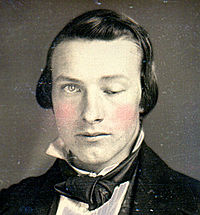
Photo from wikipedia
AIM: The aim of the study is to describe an unconventional technique of vertically split conjunctival autograft (CAG) for primary double-head pterygium and its long-term outcome. MATERIALS AND METHODS: This… Click to show full abstract
AIM: The aim of the study is to describe an unconventional technique of vertically split conjunctival autograft (CAG) for primary double-head pterygium and its long-term outcome. MATERIALS AND METHODS: This was a retrospective, noncomparative, interventional case series of 95 eyes of 95 patients, who underwent vertical, split CAG surgery without maintaining limbus–limbus orientation for primary double-head pterygium from January 2013 to January 2017. All patients were reviewed for recurrence in their follow-up period. RESULTS: The mean follow-up was 14.12 ± 9.42 months. The baseline characteristics included 44 males and 51 females, with a mean age of 56.24 ± 10.03 years. The only significant complication was recurrence rate of 2.10% (2 eyes out of 95). The most common secondary outcome was graft edema (36.84%, 35 eyes out of 95), which resolved without any intervention. The other outcomes such as graft retraction (12.63%), Tenon's granuloma (1.05%), and subconjunctival hemorrhage (34.73%) were also recorded. CONCLUSION: Unconventional vertical split CAG without maintaining limbus–limbus orientation has convincing results in treating double-head pterygium with lower recurrence rate.
Journal Title: Oman Journal of Ophthalmology
Year Published: 2019
Link to full text (if available)
Share on Social Media: Sign Up to like & get
recommendations!